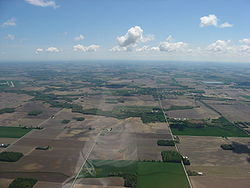- Green Springs, Ohio
-
Green Springs, Ohio — Village — Aerial view of Green Springs and the surrounding countryside Location of Green Springs, Ohio Coordinates: 41°15′26″N 83°3′6″W / 41.25722°N 83.05167°WCoordinates: 41°15′26″N 83°3′6″W / 41.25722°N 83.05167°W Country United States State Ohio Counties Sandusky, Seneca Government - Mayor Jesse Darr Area - Total 1.1 sq mi (2.8 km2) - Land 1.1 sq mi (2.8 km2) - Water 0.0 sq mi (0.0 km2) Elevation[1] 709 ft (216 m) Population (2000) - Total 1,247 - Density 1,163.1/sq mi (449.1/km2) Time zone Eastern (EST) (UTC-5) - Summer (DST) EDT (UTC-4) ZIP code 44836 Area code(s) 419 FIPS code 39-32256[2] GNIS feature ID 1061115[1] Website http://villageofgreensprings.com/ Green Springs is a village in Sandusky and Seneca counties in the U.S. state of Ohio. The population was 1,247 at the 2000 census.
Its "claim to fame" is Mineral Springs, the largest natural sulfur spring in the world.[3] St. Francis Health Care Centre is located there.[4]
Contents
History
The Green Springs area was originally inhabited by the Seneca Indians. But in 1830, the Seneca were forced to move to reservations in the West because of a policy of Indian removal developed by the administration of Andrew Jackson. Then, in 1831, Jacob Stem, the founder of Green Springs, bought the land from the government. He purchased about 1,200 acres (4.9 km2) within Sandusky and Seneca counties, including the sulfur spring. It has been told by older citizens of that time that he really did not get the spring then, but later on bought it from the Indians for 12 bags of wheat, 12 bags of oats, 12 bags of corn, and a mule. The village was originally called Stemtown, named after the founder. It was later called Green Springs, named from the color of the water from the spring.
Geography
Green Springs is located at 41°15′26″N 83°03′06″W / 41.257152°N 83.051753°W (41.257152, -83.051753).[5]
According to the United States Census Bureau, the village has a total area of 1.1 square miles (2.8 km2), all land.
State Route 19 passes through the community, the in-town portion of which is called Broadway Street.
Demographics
As of the census[2] of 2000, there were 1,247 people, 443 households, and 317 families residing in the village. The population density was 1,163.1 people per square mile (450.0/km2). There were 467 housing units at an average density of 435.6 per square mile (168.5/km2). The racial makeup of the village was 95.11% White, 0.32% African American, 0.32% Native American, 0.56% Asian, 2.17% from other races, and 1.52% from two or more races. Hispanic or Latino of any race were 5.13% of the population.
There were 443 households out of which 35.7% had children under the age of 18 living with them, 55.3% were married couples living together, 10.4% had a female householder with no husband present, and 28.4% were non-families. 23.9% of all households were made up of individuals and 11.3% had someone living alone who was 65 years of age or older. The average household size was 2.54 and the average family size was 2.97.
In the village the population was spread out with 24.3% under the age of 18, 9.1% from 18 to 24, 27.3% from 25 to 44, 20.0% from 45 to 64, and 19.2% who were 65 years of age or older. The median age was 38 years. For every 100 females there were 92.1 males. For every 100 females age 18 and over, there were 88.0 males.
The median income for a household in the village was $33,553, and the median income for a family was $43,462. Males had a median income of $32,100 versus $19,659 for females. The per capita income for the village was $17,734. About 5.4% of families and 8.7% of the population were below the poverty line, including 12.5% of those under age 18 and 11.5% of those age 65 or over.
Education
Green Springs has one elementary school, Green Springs Elementary (grades K-6), which is part of the Clyde-Green Springs Exempted Village school district.
The village is also home to one library, called Green Springs Public Library, which is a branch of the Birchard Public Library located in Fremont.
Mineral Springs
Mineral Springs at Green Springs, the largest natural sulfur spring in the world, flows up from an underground river at a rate of 8 million gallons of water every 24 hours. The overflow runs into Green Creek and eventually into Sandusky Bay and Lake Erie. In the early 19th century, Jacob Stem used the water to establish the area's first saw and grist mills. However the springs became a source for "curing all ailments." In 1868, entrepreneur Robert Smith had the water analyzed for mineral content and found it high in calcium sulfate and magnesium sulfate. Robert Smith was a very suucessful business man and was married to Catherine Stem, Jacob Stem's daughter. The area was developed to include hotels and spas, and people from many parts of Ohio and elsewhere came to be near the water. The water was also bottled and sold until the 1930s.
References
- ^ a b "US Board on Geographic Names". United States Geological Survey. 2007-10-25. http://geonames.usgs.gov. Retrieved 2008-01-31.
- ^ a b "American FactFinder". United States Census Bureau. http://factfinder.census.gov. Retrieved 2008-01-31.
- ^ "Welcome to Sandusky County, Ohio"
- ^ St. Francis Health Care Centre. Accessed 2009-03-27.
- ^ "US Gazetteer files: 2010, 2000, and 1990". United States Census Bureau. 2011-02-12. http://www.census.gov/geo/www/gazetteer/gazette.html. Retrieved 2011-04-23.
Municipalities and communities of Sandusky County, Ohio Cities Villages Townships CDPs Unincorporated
communitiesMillersville | Rollersville | Vickery
Footnotes ‡This populated place also has portions in an adjacent county or counties
Municipalities and communities of Seneca County, Ohio Cities Villages Attica | Bettsville | Bloomville | Green Springs‡ | New Riegel | Republic
Townships Unincorporated
communitiesFootnotes ‡This populated place also has portions in an adjacent county or counties
Categories:- Villages in Ohio
- Populated places in Sandusky County, Ohio
- Populated places in Seneca County, Ohio
Wikimedia Foundation. 2010.




